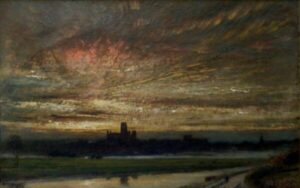Description
It is highly likely that Cox submitted this watercolour to Wrightson and Webb for publication in Thomas Roscoe’s book: Wanderings and Excursions in South Wales, [1837]; if so, then the scene had been rejected for an alternative view of ‘Mumbles Lighthouse’ by E. Watson, illustrated chapter XV, between pages 224 and 225.
However, the following description given by the author, Thomas Roscoe, relates very closely to our watercolour; chapter XV pages 223-224.
Thomas Roscoe (1791-1871). Wanderings and Excursions in South Wales; Including the Scenery of the River Wye. London: C. Tilt and Simpkin and Co.; Birmingham: Wrightson and Webb, [1837]. Steel engravings by William Radclyffe.
Pages 223-224: The sweep of Swansea Bay comprehends many objects of great interest. In an angle formed by the indention of its bending shore, about five miles from the town, stands the remains of Oystermouth Castle. This fortress occupies a gentle eminence close to the shore and belonged from a remote period to the Lords of Gower. Its walls are still nearly entire. In the hour of its pride, it has frowned defiance upon many hostile hosts that have successively unfurled their banners before it. To add to its strength and importance, tradition relates that a subterraneous communication was made between this castle and Swansea. Its bold and majestic ruins are now seen by the far-off mariner from his skiff on the waters.
The pleasant village of the same name spreads its scattered habitations on the declivity of the hilly range near which the castle stands, under the shadow of a limestone rock, and reaches to the dry and somewhat elevated part of the beach within the Mumble’s Point. This later object is a bold rocky projection, running some distance into the sea, and bears the Pharos of the part of the Island coast which is washed by the waters of the Bristol Channel.
————————————————————————————————————————————————————————————————-
Cox provided forty-nine illustrations for his last and most extensive venture into book illustration in Thomas Roscoe’s two volumes on Wales. As with Graphic Illustrations of Warwickshire a decade earlier, his involvement in the project was the result of his friendship with the Birmingham engraver William Radclyffe.
The ninety-nine steel-engraved plates of the two books on Wales constitute Radclyffe’s most ambitious work, and it was he who persuaded the Birmingham publishers, Wrightson and Webb, to commission Cox to provide drawings for engraving. Radclyffe’s intention was that Cox be responsible for all the illustrations; however, the publishers also commissioned other artists, including George Cattermole, Anthony Vandyke Copley Fielding, James Duffield Harding, Thomas Creswick, and, in the second volume, David Cox Jr. Nonetheless, Cox provided half the illustrations: thirty-one of the fifty-one plates in Wanderings and Excursions in North Wales and eighteen of the forty-eight plates in the companion volume on South Wales which appeared around a year later.
Cox travelled in Wales in the early autumn of 1836, making drawings for the project. In October he stayed with Radclyffe in Birmingham, and, in a letter of 13 October, he wrote that he was busy preparing a drawing for the engravers. This must have been for the second volume, on which Cox was still at work in March the following year. In a letter to William Turton, 22 March 1837, Cox wrote: “For the last fortnight I have been so much engaged finishing the remainder of the Drawings for S. Wales”.



